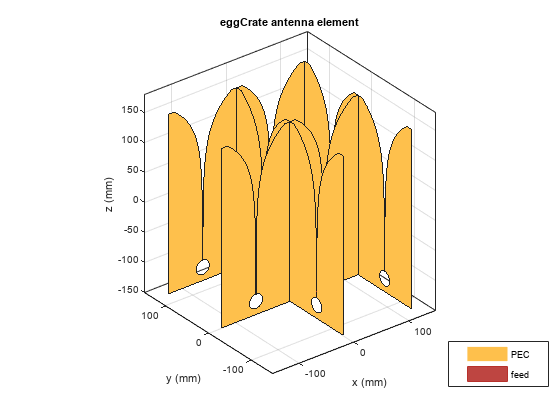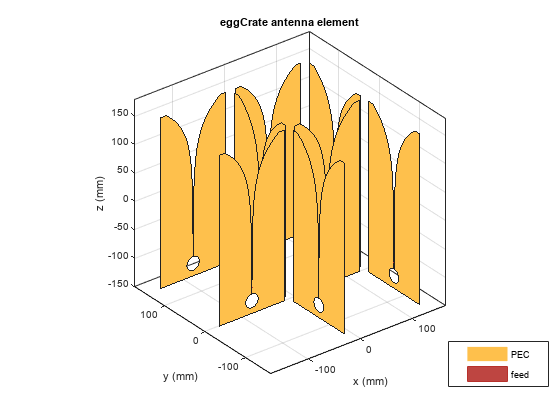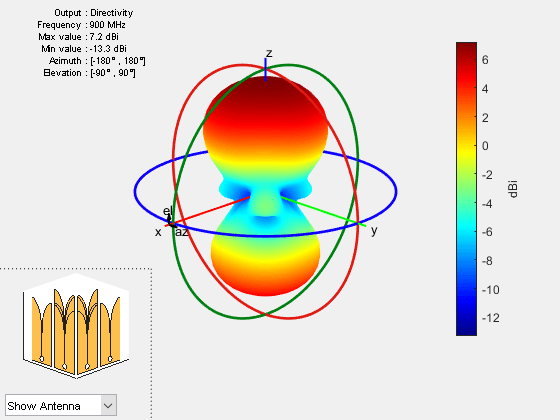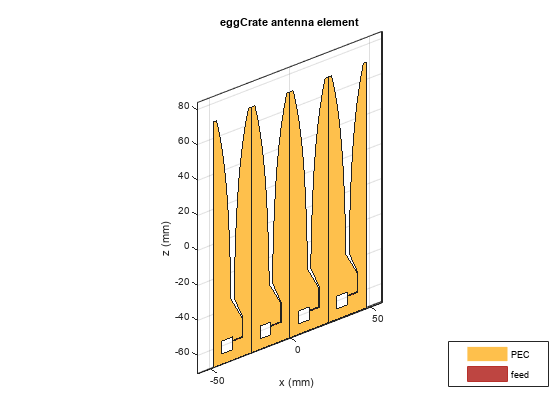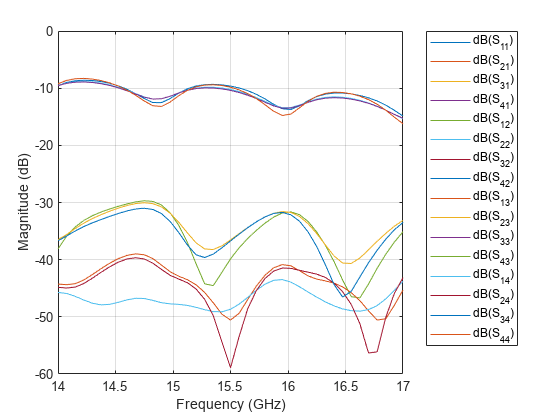eggCrate
Description
The default eggCrate object creates an array of Vivaldi antenna
elements arranged in a rectangular egg-crate structure. Egg crate arrays are used in phased
array applications in radar systems.
Creation
Description
array = eggCrate
array = eggCrate(PropertyName=Value)PropertyName is the property
name and Value is the corresponding value. You can specify several
name-value arguments in any order as
PropertyName1=Value1,...,PropertyNameN=ValueN. Properties that you
do not specify, retain their default values.
For example, array = eggCrate(Element=vivaldiOffsetCavity)
creates an egg-crate array of vivaldiOffsetCavity object.
Properties
Object Functions
axialRatio | Calculate and plot axial ratio of antenna or array |
beamwidth | Beamwidth of antenna |
charge | Charge distribution on antenna or array surface |
current | Current distribution on antenna or array surface |
efficiency | Calculate and plot radiation efficiency of antenna or array |
EHfields | Electric and magnetic fields of antennas or embedded electric and magnetic fields of antenna element in arrays |
feedCurrent | Calculate current at feed for antenna or array |
impedance | Calculate and plot input impedance of antenna or scan impedance of array |
info | Display information about antenna, array, or platform |
memoryEstimate | Estimate memory required to solve antenna or array mesh |
mesh | Generate and view mesh for antennas, arrays, and custom shapes |
meshconfig | Change meshing mode of antenna, array, custom antenna, custom array, or custom geometry |
msiwrite | Write antenna or array analysis data to MSI planet file |
optimize | Optimize antenna and array catalog elements using SADEA or TR-SADEA algorithm |
pattern | Plot radiation pattern of antenna, array, or embedded element of array |
patternAzimuth | Azimuth plane radiation pattern of antenna or array |
patternElevation | Elevation plane radiation pattern of antenna or array |
peakRadiation | Calculate and mark maximum radiation points of antenna or array on radiation pattern |
rcs | Calculate and plot monostatic and bistatic radar cross section (RCS) of platform, antenna, or array |
returnLoss | Calculate and plot return loss of antenna or scan return loss of array |
show | Display antenna, array structures, shapes, or platform |
solver | Access FMM solver settings for electromagnetic analysis |
sparameters | Calculate S-parameters for antenna or array |
stlwrite | Write mesh information to STL file |
vswr | Calculate and plot voltage standing wave ratio (VSWR) of antenna or array element |
Examples
More About
References
[1] Chu, Hao-Lung, Ghanshyam Mishra, and Satish K. Sharma. “Dual Polarized Wideband Vivaldi 4x4 Subarray Antenna Aperture for 5G Massive MIMO Panels with Simultaneous Multiple Beams.” In 2018 18th International Symposium on Antenna Technology and Applied Electromagnetics (ANTEM), 1–2. Waterloo, ON: IEEE, 2018. https://doi.org/10.1109/ANTEM.2018.8572871.
[2] R. Hahnel and D. Plettemeier, "Dual-polarized Vivaldi array for X- and Ku-Band," Proceedings of the 2012 IEEE International Symposium on Antennas and Propagation,2012, pp. 1-2.
[3] Yan, J., S. Gogineni, Bruno Camps-Raga and J. Brozena. “A Dual-Polarized 2–18-GHz Vivaldi Array for Airborne Radar Measurements of Snow.” IEEE Transactions on Antennas and Propagation, 2016, vol. 64, pp. 781-785.
Version History
Introduced in R2021a
